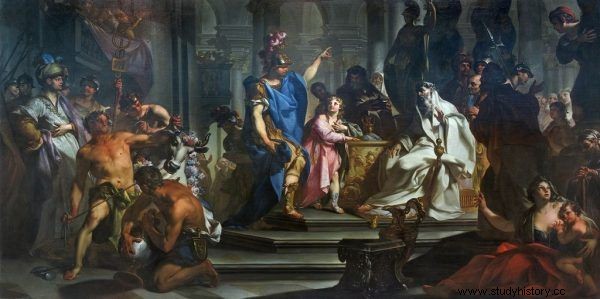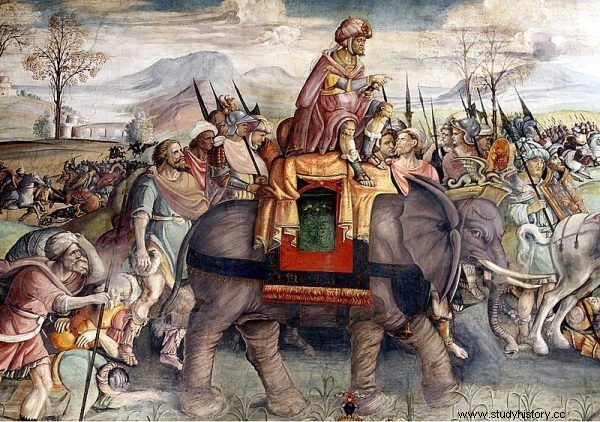This clash of ancient powers could have cost the lives of nearly 60,000 people. Two huge armies faced each other. Determination and strategy prevailed, so ingenious that even modern commanders are modeled on it.
In the 3rd century BC, two dynamically developing centers competed for influence in the western Mediterranean:Rome and Phoenician (or, in Latin, Punic) Carthage.
The first war between them took place in the years 264-241 BC, but over twenty years of struggle did not end the conflict conclusively. The African city-state, though a losing party, continued to expand, especially in Spain.

One of the Roman consuls was killed in the battle.
Another clash was inevitable. The treaty, which delimited the spheres of influence of rivals on the Iberian Peninsula on the River Ebro, was only a temporary solution. The Romans themselves provided a pretext, encouraging the city of Sagunt, located in the territories dominated by Carthaginians, to take a stand against the metropolis. And when the Punic governor of Spain, Hannibal of the Barkid family, set out to punish the rebels, they sent him an envoy not to intervene.
It is hardly surprising that the Carthaginian commander simply rejected a brazen ultimatum in breach of his earlier agreements. He besieged and captured the city. The Romans were just waiting to declare war on him. And at their own request, they unleashed a conflict that cost them unbelievably a lot of blood, effort, material and prestige losses.
Born commander
The leaders of the Eternal City themselves did not know the great misfortune they were bringing upon themselves. Hannibal was only 27 years old, but he was an experienced leader. His innate military talent allowed him to successfully fight even stronger opponents. He was also able to obey his troops, composed mainly of mercenaries of various nations fighting for loot and money. Because he stayed close to the soldiers, froze with them, suffered from hunger and slept on the bare ground, he won their love and appreciation.

Hannibal, even as a child, vowed to remain Rome's enemy for the rest of his life.
In preparation for the war, Hannibal gathered and trained in Spain a huge army of Africans, Iberians, and later Gauls as well. The Roman historian Livy, thanks to whom we know the course of this conflict, wrote that it had as many as 90,000 walkers and 12,000 horsemen. She was accompanied by 37 elephants.
These forces moved north towards Gaul and, after crossing the Rhône, faced the Alps. The crossing of the high mountains turned out to be extremely difficult. Many soldiers died, many fell ill, and some animals and equipment were lost. But something extraordinary succeeded:an army of many thousands of Southerners, without losing its cohesiveness and operational value, crossed a mountain range several thousand meters high and entered Italy.
After several victories and a winter in the north of the Apennine Peninsula, Hannibal defeated his opponents on Lake Trasimeno on June 21, 217 BC. Then began to ravage Roman mansions. It was disastrous for the Eternal City, because at that time the state had not yet imported grain from the provinces, but was largely dependent on its own crops. The Carthaginians raged in Italy for a year without encountering much resistance. The Romans hoped that starvation, disease and other natural factors would weaken the forces of the invaders.
Soon, however, some Roman senators began to oppose this passive strategy. They demanded that Hannibal be given a fight and defeated him. An advocate of such activities was, among others, Gaius Terentius Varro, who in 216 BC became one of the two consuls. These top officials were also military commanders. Unfortunately, along with him, the office was held by Lucius Emiliusz Paulus, who wanted to continue the current tactic of avoiding a general fight. The two leaders took turns in command every other day. One can imagine that with such a disagreement it was disastrous.
Preparing for battle
Finally, at the end of July 216 B.C.E. the Roman army approached the city of Kanna in the south of the Apennine Peninsula. Hannibal was waiting for her there. Two large forces faced each other. The Romans had divisions of over 86,000 people. There were about 50,000 Carthaginians.

Legionnaires were in the center of the Roman groups. The photo shows the reconstruction group from UMCS.
The battle took place in the morning of August 2. According to Livy, Roman groups were located between the Aufidius River (today Ofanto) and a range of low hills. The consuls wanted to avoid being outflanked by the numerous Punic cavalry. On the right wing, near the river, they set up a cavalry, and then on foot. On the left wing, they placed allied regiments, next to which stood the legionary infantry. The latter, well-armed and armored, made up of experienced soldiers, the tactic involved hitting a powerful center consisting of three heavy-armed infantry throws and breaking enemy lines. In the foreground, however, skirmishers, i.e. light auxiliary infantry, were placed.

Hannibal placed his troops quite loosely, creating a crescent in the center aimed at the Romans.
Interestingly, the historians' analyzes show that the forces of the Eternal City were very tight. The line of the maniple, or tactical unit, was five men wide and 30 meters deep. The entire Roman army was only three kilometers long.
Meanwhile, Hannibal set all his heavily armed Iberian and Gallic cavalry under the command of Hasdrubal on the left wing. The Numidian cavalry hit the right wing. Most of the African, Iberian, and Gallic infantry were at the center. The chief lined it up in a long line that curved into a crescent. Its bulge was pointing towards the opponent. It was there - in the least favorable place - that the Gauls were placed. But on them, as one of the modern monographs of the battle stated, the Carthaginian commander simply cared the least ...
"Barbaric clash"
Skirmishers started the fight, throwing spears and projectiles from slingshots. Their skirmishes, however, were quickly interrupted by the main attack. The entire left wing of the enemy moved to the Roman cavalry. The Carthaginians, blocked by a nearby river, could not approach the enemy from the side, so they had to charge frontally.
The Romans withstood the blow. During the fierce fight, the riders from both sides tried to smash or at least push away the opponent. The Greek chronicler Polybius noted that there was a truly barbaric clash. As the author of the book "The Battle of Cannaes 216 BCE" writes, Mark Healy:
Swords flashed, people struggled, jerked and dragged them to the ground. The fight was nothing like a horse fight. In the enormous crowd, the riders fought like walkers. The numerical superiority of the Carthaginians meant that the Romans began to slowly retreat .
This part of the Roman army was commanded by consul Paulus. Already at the beginning of the battle, he was injured by a slingshot stone and fell (or dismounted) from his horse. It had tragic consequences. His subordinates took it as an order and ... also began to dismount from their horses to fight on foot. "Better if he had them tied up, he had them handed over to me anyway" Hannibal said later.

Long after Hannibal's expedition to Italy, the Romans trembled at the mere mention of his army.
The Punic cavalry began the slaughter of the Romans. Those who did not manage to mount their horses quickly and escape, died from the swords, spears and hooves of the enemy's mounts. Some, running down the river escarpment, jumped into the water to save their lives. The cavalry of the future empire was completely shattered. After eliminating the enemy cavalry, as requested by Hannibal, Hasdrubal hit the enemy from behind.
The lap closes
The light Roman infantry struck the center of Hannibal's troops first. She didn't achieve much, however, and soon had to retreat to the rear. Then the horns sounded, i.e. the signal to attack the main forces gathered in this section. As Mark Healy recounts:
Hastati [spearmen - ed. PS] they moved forward with a steady pace, rhythmically hitting their spears against the backs of the shields. The attacking Romans had the colorful ranks of the enemy before their eyes. The contingents of Iberian soldiers, dressed in white tunics with purple trim, were interspersed with troops of half-naked Celts, gazing wildly at their opponent . They wore multicolored pants and, as was their custom, they had their hair stiffened with white lime, which made them look taller than they really were .
The spearmen threw javelins at the enemy. Then they took their swords and attacked the enemy ranks. Now the genius of setting up the Carthaginian troops is fully revealed. The bend of the infantry line meant that some Romans almost immediately hit their opponents, and the rest had to run a little further. In addition, the alternation of Iberian and Gallic troops made them fight two opponents at once. And those who used different weapons and fought differently. For the Gauls cut and the Iberians used thrusts.
Meanwhile, Hannibal rode into the hollow of the crescent moon and encouraged his people to persevere. The pressure was strong, however. The Carthaginian line began to bend the other way. The legionnaires were sure that the enemy formation was breaking and they pushed even harder in the center. They did not notice that heavy African infantry were waiting on Carthaginian wings.
As Livy reported, these units were dressed in chain mail captured by the Romans in the Battle of Lake Trasimensky. As a result, they reminded the legionnaires of their own units from a distance. And they took them by surprise.
The Africans formed a phalanx and struck, sweeping the enemy inside. The attackers' wings moved closer and closer until they finally closed the ring of encirclement. The legionnaires were so cramped that they couldn't turn around. Some people couldn't even raise their sword!

Hannibal, alone in the midst of the turmoil of battle, cheered his soldiers on.
The Romans tried to get out of the trap, but to no avail. The Battle of Cannae turned out to be the greatest defeat in Roman history. They were literally cut out. Historians estimate that on the lost side as many as 47,000 infantry and 2,700 cavalrymen died. Another 19,000 people were captured. Losses reached the highest levels - 29 military tribunes and over 80 senators were killed. One of the consuls, Emilius Paulus, who opposed the violent actions, lost his life. Varron, a supporter of a general battle, survived and escaped from the battlefield. At this scale of defeat, the losses of Carthage - 8,000 souls, mainly Iberians and Gauls, seem small. The Roman authorities returned to the strategy of avoiding major battles and focused on harassing the Carthaginian troops, and it was decided to launch an offensive in Spain. The famous saying "hannibal ante portas" also comes from this period, meaning the imminent and great danger.
The Battle of Cannae went down in history as one of the greatest clashes of antiquity. To this day, it is also given as an example of an excellent military tactic. Over the centuries, many commanders have tried to repeat Hannibal's brilliant flanking maneuver with greater or lesser success.
Inspiration:
The article was inspired by the latest book by Ben Kane, entitled Hannibal. Enemy of Rome , which was released by the Znak Horyzont publishing house.
Bibliography:
- Mark Healy, Battle of Cannae 216 BC , Amercom 2010.
- Battle of Cannae, August 2, 216 BC , "Rzeczpospolita", series "Battles of the World", no. 3 (March 31, 2007).
- Janusz Sikorski, Cannas 216 BCE , Bellona 2012.
